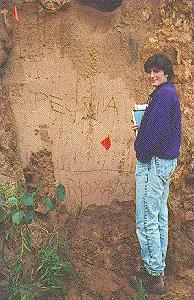Excerpts from
Eight Months in Illinois
By William Oliver, 1843

Speculation on the Origins of the Soils
It is, perhaps, unnecessary in a work like this, even if I possessed the requisite qualifications, to enter into the subject of the formation of the prairies. I may state, however, that those of the southern part of Illinois appeared to me to have been produced by a deposit, which had been made in comparatively tranquil water, as it consists of very fine calcareous clay, in some places mixed with sand and gravel, the latter mostly about the size of peas or small beans.
I never saw a stone on the surface, although I have seen a few of considerable size in the channels of the creeks and branches, and which did not belong to the neighborhood. The uniformity in the level of the most elevated parts, except in some solitary instances, which, from their peculiar formation, appear to have been islands, may surely be esteemed of some weight, in the presumption that the country has at one time formed the bottom of a lake. It may be asked, why are there such inequalities in its surface - why is it not a dead level, if it formed the bottom of a lake?
Many of the inequalities have evidently been caused by the watercourses, and who shall say how and where the waters ran, before they succeeded in scooping out the present valleys? They might meander and change their course over the entire surface of what would constitute a muddy plain, a scoop out a number of temporary channels, which, as the level was lowered, would gradually be abandoned for one course. From the general appearance of the country, I think it is not at all unlikely that the basin of the lake had been nearly filled up by the immense quantity of matter brought down by the waters at present constituting the Missouri and Mississippi.
The Niagara, or dam of this supposed lake, or body of lakes, seems to have been at Grand Tower (six or seven miles from the mouth of the Big Muddy river), where the Mississippi is confined between very high rocks, in many places perpendicular. - Now, looking at Colton and Company's map of Illinois, in which the prairies are accurately indicated, it will be seen that the Grand Tower is their southern limit. When the country is so level that a rise of ten feet on the Mississippi dams back the Okau upwards of twenty miles, it may be readily conceived that an elevation of some hundreds of feet would inundate an immense tract of country.
The barrier at Grand Tower certainly will not account for all the very extensive prairies in the Mississippi Valley, but it may perhaps account for those in its more immediate neighborhood, since it might still retain a large body of water, after the surface of the North American continent had emerged from the state of inundation to which it has evidently been very generally exposed.
— Pages 59-61, Southern Illinois University Press, 2002 edition
What do we know today that William Oliver did not know? How do we know?







